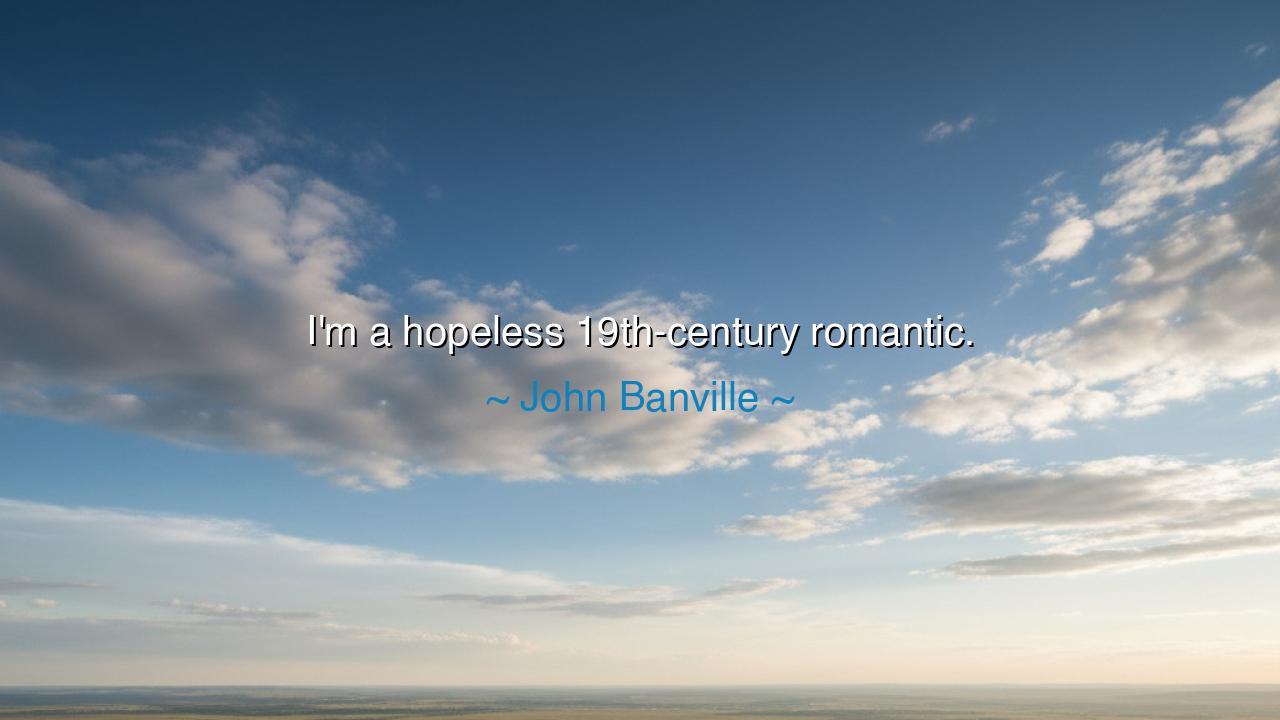
I'm a hopeless 19th-century romantic.






The words of John Banville—“I’m a hopeless 19th-century romantic.”—ring like a confession both tender and defiant. To call oneself a romantic is already to admit to seeing the world through the lens of longing, beauty, and heightened emotion. But to be a 19th-century romantic is to claim kinship with an era when poetry, music, and literature exalted the individual soul, when the storms of passion and the grandeur of nature were revered as sacred. And to be hopeless in that romance is to acknowledge that, even in a modern age that prizes irony and detachment, one cannot help but be drawn to that older vision of the world.
In the 19th century, the Romantic movement reshaped the spirit of art and thought. It was the time of Byron, Shelley, Keats, and Wordsworth—poets who poured fire into their words and saw the world as alive with divine significance. It was the time of Beethoven, whose symphonies thundered with both rage and exaltation, and of painters who captured landscapes not as mere scenery but as vast mirrors of the human soul. To be a “19th-century romantic” is to carry that torch, to see the world not only as it is but as it feels, to embrace the sublime in both beauty and sorrow. Banville, in naming himself such, reveals a spirit out of step with the cynicism of his time, yet all the richer for it.
The hopelessness he speaks of is not despair but devotion. It is the recognition that such a sensibility cannot be unlearned, that even if the world sneers at sentiment, one’s heart still aches at sunsets, at poetry, at tragic love. It is hopeless because it is incurable; it is a condition of the soul. And in truth, this hopelessness is its own strength, for it keeps alive in a weary age the belief that beauty and longing matter, that they give meaning to existence.
We see echoes of this spirit throughout history. Consider Victor Hugo, whose writings in the 19th century soared between the political and the personal, between revolutions and romances, weaving the cries of nations together with the whispered prayers of lovers. His Les Misérables is not simply a tale of politics, but of love in all its forms: paternal, romantic, divine. Or think of Frédéric Chopin, whose music, fragile and aching, distilled the very essence of romantic yearning. These figures remind us that to be a 19th-century romantic is to believe that art and love are inseparable from life itself.
The meaning of Banville’s declaration, then, is more than personal; it is a resistance against modern detachment. In a world that often prizes wit over sincerity and irony over passion, he chooses to stand with the Romantics, who dared to feel deeply, even at the risk of seeming foolish. His “hopelessness” is a refusal to abandon what is eternal: the longing for beauty, the reverence for emotion, and the conviction that truth is found not only in reason but in the heart.
The lesson for us is simple yet profound: do not be ashamed of your own romanticism. Do not despise the part of you that longs, that dreams, that weeps at poetry or trembles at the sound of music. The world may call it impractical, but it is the essence of being alive. To feel deeply is not weakness but strength, for it connects us to what is eternal in the human spirit.
Practically, this means cultivating spaces in life where romance—in the broadest sense—may thrive. Read the poets, listen to the symphonies, walk in nature and let it speak to you. Dare to love not cautiously, but with the fullness of your being. And above all, let your own hopelessness for beauty and meaning be a beacon, not a burden, for those around you.
Thus, Banville’s words stand as both confession and challenge. To be a hopeless 19th-century romantic is to live as if beauty still matters, as if passion still matters, as if the heart’s cry is still the most truthful song. It is to resist the hollow laughter of a cynical age and to cling instead to the flame of wonder. And this flame, though hopeless in the eyes of the world, is the very hope that keeps the human soul alive.






AAdministratorAdministrator
Welcome, honored guests. Please leave a comment, we will respond soon